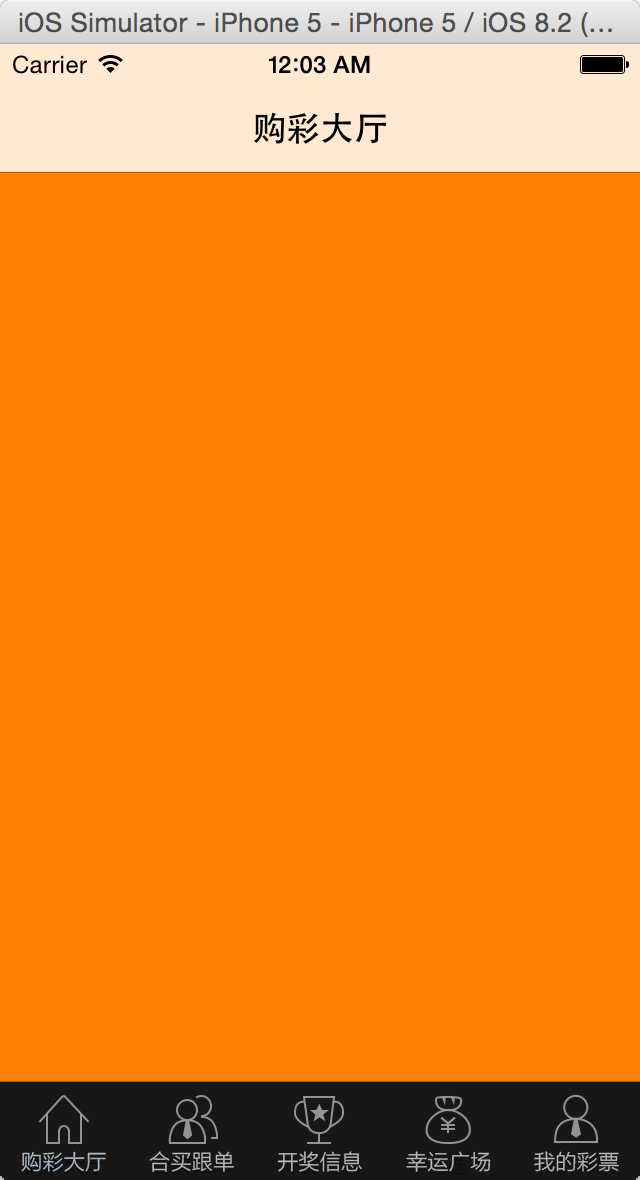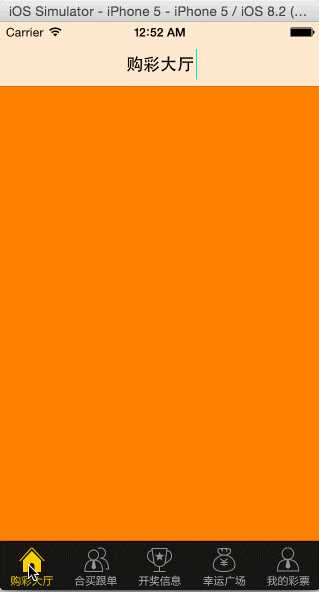标签:
在上一篇中,我们基本已经把整个框架都搭建出来了,下面进行代码重构一下。
思路:
一.自定义UIButton,继承自UIButton。MJTabBarButton.m
#import "MJTabBarButton.h" @implementation MJTabBarButton - (id)initWithFrame:(CGRect)frame { self = [super initWithFrame:frame]; if (self) { // Initialization code } return self; } /** * 只要覆盖了这个方法,按钮就不存在高亮状态 */ - (void)setHighlighted:(BOOL)highlighted { // } @end
二.定义一个View,封装创建tarbar按钮的方法。
MJTabBar.h
#import <UIKit/UIKit.h> @interface MJTabBar : UIView -(void)addTabBarWithName:(NSString *)name selName:(NSString *)selName; @end
MJTabBar.m
// // MJTabBar.m // Lottery // // Created by jiangys on 15/8/30. // Copyright (c) 2015年 weconex. All rights reserved. // #import "MJTabBar.h" #import "MJTabBarButton.h" @implementation MJTabBar //创建tabBar按钮 -(void)addTabBarWithName:(NSString *)name selName:(NSString *)selName { MJTabBarButton *button=[MJTabBarButton buttonWithType:UIButtonTypeCustom]; //设置图片 [button setBackgroundImage:[UIImage imageNamed:name] forState:UIControlStateNormal]; [button setBackgroundImage:[UIImage imageNamed:selName] forState:UIControlStateSelected]; //添加 [self addSubview:button]; } //该方法通常是设置控件的尺寸,initWithFrame负责创建控件,initWithFrame下的frame是没有值的。 -(void)layoutSubviews { [super layoutSubviews]; NSUInteger count=self.subviews.count; for (NSUInteger i=0; i<count; i++) { MJTabBarButton *button=self.subviews[i]; button.tag=i; //设置frame CGFloat buttonY=0; CGFloat buttonW=self.frame.size.width/count; CGFloat buttonH=self.frame.size.height; CGFloat buttonX=i*buttonW; button.frame=CGRectMake(buttonX, buttonY, buttonW, buttonH); } } @end
那么,MJTabBarController.m里加载底部的tabBar就很简单了
// // MJTabBarController.m // Lottery // // Created by apple on 15/8/27. // Copyright (c) 2015年 weconex. All rights reserved. // #import "MJTabBarController.h" #import "MJTabBar.h" @interface MJTabBarController ()@end @implementation MJTabBarController - (void)viewDidLoad { [super viewDidLoad]; // 1.添加自己的tabbar MJTabBar *myTabBar = [[MJTabBar alloc] init]; myTabBar.frame = self.tabBar.bounds; [self.tabBar addSubview:myTabBar]; // 2.添加5个按钮 for (int i = 0; i<self.viewControllers.count; i++) { NSString *name=[NSString stringWithFormat:@"TabBar%d",i+1]; NSString *selName=[NSString stringWithFormat:@"TabBar%dSel",i+1]; [myTabBar addTabBarWithName:name selName:selName]; } } @end
运行后的效果:

目前还不能点击底部的那几个tarBar按钮,拉下来,我们通过代理的方式来实现。
三.通过代理方式实现底部按钮点击切换
1.定义协议。在MJTabBar.h文件最上边声明协议
@class MJTabBar; @protocol MJTabBarDelegate <NSObject> -(void)tabBar:(MJTabBar *)tabBar didSelectButtonFrom:(int)from to:(int)to; @end
2.定义代理。继续在MJTabBar.h中声明一个委托的变量
//声明委托变量 @property(nonatomic,weak)id<MJTabBarDelegate> delegate;
MJTabBar.h完整代码
#import <UIKit/UIKit.h> @class MJTabBar; @protocol MJTabBarDelegate <NSObject> -(void)tabBar:(MJTabBar *)tabBar didSelectButtonFrom:(int)from to:(int)to; @end @interface MJTabBar : UIView //声明委托变量 @property(nonatomic,weak)id<MJTabBarDelegate> delegate; -(void)addTabBarWithName:(NSString *)name selName:(NSString *)selName; @end
3.通知代理。在MJTabBar.m完整代码
// // MJTabBar.m // Lottery // // Created by jiangys on 15/8/30. // Copyright (c) 2015年 weconex. All rights reserved. // #import "MJTabBar.h" #import "MJTabBarButton.h" @interface MJTabBar() /** * 记录当前选中的按钮 */ @property (nonatomic, weak) UIButton *selectedButton; @end @implementation MJTabBar //创建tabBar按钮 -(void)addTabBarWithName:(NSString *)name selName:(NSString *)selName { MJTabBarButton *button=[MJTabBarButton buttonWithType:UIButtonTypeCustom]; //设置图片 [button setBackgroundImage:[UIImage imageNamed:name] forState:UIControlStateNormal]; [button setBackgroundImage:[UIImage imageNamed:selName] forState:UIControlStateSelected]; //添加 [self addSubview:button]; //监听 [button addTarget:self action:@selector(buttonClick:) forControlEvents:UIControlEventTouchDown]; //默认选中第0个按钮 if (self.subviews.count==1) { [self buttonClick:button]; } } //该方法通常是设置控件的尺寸,initWithFrame负责创建控件,initWithFrame下的frame是没有值的。 -(void)layoutSubviews { [super layoutSubviews]; NSUInteger count=self.subviews.count; for (NSUInteger i=0; i<count; i++) { MJTabBarButton *button=self.subviews[i]; button.tag=i; //设置frame CGFloat buttonY=0; CGFloat buttonW=self.frame.size.width/count; CGFloat buttonH=self.frame.size.height; CGFloat buttonX=i*buttonW; button.frame=CGRectMake(buttonX, buttonY, buttonW, buttonH); } } /** * 监听按钮点击 */ -(void)buttonClick:(UIButton *)button { //通知代理 if ([self.delegate respondsToSelector:@selector(tabBar:didSelectButtonFrom:to:)]) { [self.delegate tabBar:self didSelectButtonFrom:self.selectedButton.tag to:button.tag]; } // 1.让当前选中的按钮取消选中 self.selectedButton.selected = NO; // 2.让新点击的按钮选中 button.selected = YES; // 3.新点击的按钮就成为了"当前选中的按钮" self.selectedButton = button; } @end
4.委托页面,实现代理协议。MJTabBarController.m 实现
@interface MJTabBarController () <MJTabBarDelegate> @end
5.委托页面,先让自己成为代理,并实现代理方法。MJTabBarController.m 实现:
myTabBar.delegate = self;
- (void)tabBar:(MJTabBar *)tabBar didSelectButtonFrom:(int)from to:(int)to { // 选中最新的控制器 self.selectedIndex = to; }
委托页面的完整代码:
// // MJTabBarController.m // 00-ItcastLottery // // Created by apple on 14-4-14. // Copyright (c) 2014年 itcast. All rights reserved. // #import "MJTabBarController.h" #import "MJTabBar.h" //#import "MJTabBarButton.h" @interface MJTabBarController () <MJTabBarDelegate> @end @implementation MJTabBarController - (void)viewDidLoad { [super viewDidLoad]; // 1.添加自己的tabbar MJTabBar *myTabBar = [[MJTabBar alloc] init]; myTabBar.delegate = self; myTabBar.frame = self.tabBar.bounds; [self.tabBar addSubview:myTabBar]; // 2.添加对应个数的按钮 for (int i = 0; i < self.viewControllers.count; i++) { NSString *name = [NSString stringWithFormat:@"TabBar%d", i + 1]; NSString *selName = [NSString stringWithFormat:@"TabBar%dSel", i + 1]; [myTabBar addTabButtonWithName:name selName:selName]; } } /** normal : 普通状态 highlighted : 高亮(用户长按的时候达到这个状态) disable : enabled = NO selected : selected = YES */ #pragma mark - MJTabBar的代理方法 - (void)tabBar:(MJTabBar *)tabBar didSelectButtonFrom:(int)from to:(int)to { // 选中最新的控制器 self.selectedIndex = to; } @end
最终运行后的效果:

源代码下载:点击下载
标签:
原文地址:http://www.cnblogs.com/jys509/p/4772076.html